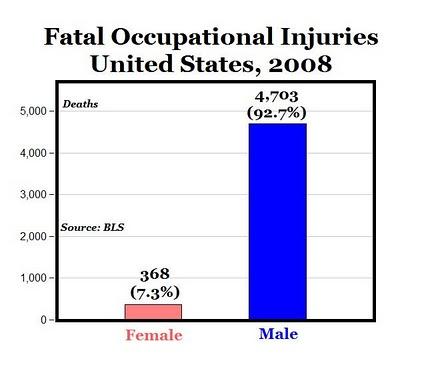Mark Perry channels Gary Becker.
As the recent all-male coal mining deaths in West Virginia illustrate, a disproportionate number of men work in higher-risk occupations that are typically compensated with higher pay like coal mining (almost 100% male), fire fighters (96.6% male), police officers (84.5% male), correctional officers (73.1% male), and construction (97.4% male), BLS data here. A disproportionate number of women work in lower-risk, more comfortable and safer industries, often with lower pay to compensate for the more worker-friendly, indoor, comfortable, air-conditioned office environments, like Office and Administrative Support Occupations (74.5% female), Education, Training and Library Occupations (74.3%), and Healthcare (74.6%). These differences in work environments could likely reflect differences in “revealed preference” by gender – men prefer higher-paid, higher risk occupations, and women prefer lower-paid, lower risk occupations, in general and on average. It might not have anything to do with discrimination, and everything to do with differences in risk tolerances and risk-reward preferences.
To achieve gender pay equity, there will have to be an increase in the number of women in higher-paying, but higher-risk occupations like coal mining. That outcome will certainly reduce the gender pay gap, but it will come at a huge cost: sentencing thousands of women per year to certain fatal occupational deaths. Would closing the pay gap, if it also means closing the gender occupational death gap and exposing thousands of women to work-related deaths each year, really be worth it for women?
His post was motivated by this chart:
Or how about thinking about this another way. The article Perry sites is about “Equal Pay Day””
“The next Equal Pay Day is Tuesday, April 20, 2010. This date symbolizes how far into 2010 women must work to earn what men earned in 2009. Because women earn less, on average, than men, they must work longer for the same amount of pay. Equal Pay Day was originated by the National Committee on Pay Equity (NCPE) in 1996 as a public awareness event to illustrate the gap between men’s and women’s wages.”
“The next “Equal Pay Day” is January 1, 2012. This date symbolizes how far into the future women college professors of economics must work to earn what men earned people with similar credentials but working as consultants, researchers or bankers in 2009. Because women college professors earn less, on average, than men PhDs in private industry, they must work longer for the same amount of pay. Equal Pay Day was originated by the National Committee on Pay Equity (NCPE) in 1996 as a public awareness event to illustrate the gap between men’s non-college professors and women’s college professors’ wages.”
“The next Equal Pay Day is Tuesday, April 20, 2010. This date symbolizes how far into 2010 women secretaries in Rochester, NY must work to earn what men women secretaries in New York City earned in 2009. Because Rochester women earn less, on average, than men New York City women, they must work longer for the same amount of pay. Equal Pay Day was originated by the National Committee on Pay Equity (NCPE) in 1996 as a public awareness event to illustrate the gap between men’s New York women’s and Rochester women’s wages.”

I think it was Alan Greenspan who took advantage of discrimination by hiring only women economists. That’s the nice thing about the free market; you can discriminate if you want, but you’ll have to pay for it.
This is the biggest straw man argument there is. There’s already research that shows that women within the SAME occupational categories earn less than men, even when seniority and time on the job are adjusted for. For example, if you visit the Chronicle of Higher Education webpage and look at the AAUP average faculty salaries, for nearly every university listed at every level of employment women have a lower average salary than men. This means that female assistant professors earn less than male assistant professors, even though these positions are at the same level in the employment level!
The pay gap isn’t solely due to differences in work choices, nor is it true that men universally choose higher paying careers. Also, use your brain and put a little thought into why certain male-dominated careers are more highly paid whereas certain female-dominated careers that require huge workloads and/or higher education (such as nurse managers, teachers, and social workers) are low-paid.